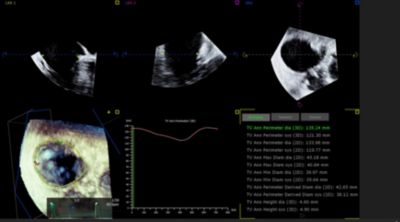
AI-based echo: obtaining accurate peri-procedure measurements of the TV annulus
- By
- July 31 2025
- 5 min read
Obtaining accurate pre-procedure measurements of the tricuspid valve annulus
Tricuspid regurgitation (TR) represents a distinctive entity with clear adverse prognostic implications, which are independent of left ventricular function and pulmonary hypertension [1, 2]. Due to increased mortality from isolated tricuspid valve (TV) surgery [3], the number of transcatheter TV interventions is expanding, with new devices emerging. This growth in transcatheter TV interventions demands precise assessment of the complex anatomy and function of the TV. An AI-powered 3D Auto Tricuspid Valve quantification tool can help by providing automated 3D peri-procedure measurements.
At-a-glance:
- Workflow: The AI-based software follows a functional echo workflow
- Analysis I: Specific tricuspid valve annular measurements are derived automatically
- Analysis II: Specific measurements for valve replacements are automatically provided
- Validation: A study was conducted to evaluate the algorithmic performance of the software

The 3D Auto TV software was developed to support accurate clinical evaluation of the tricuspid valve annulus and provide users with reproducible results for their consideration to assist them in validating their clinical evaluation. Reproducibility is measured as agreement between reviewers in a clinical performance validation study. In addition, in developing the new tool, agreement with previously validated tools was analyzed to ensure high performance of the new tool.
Validation study
A study was conducted to evaluate the algorithmic performance of the 3D Auto TV software, where transesophageal echocardiography (TEE) cardiac clips from 97 subjects and transthoracic echocardiography were used for TV annulus measurements by three clinical experts (reviewers). The reviewers used 3D Auto TV software for the measurements and the results were compared to the results of manual measurements by the same reviewers. The manual measurements, which were performed within the 4D Cardio-View application, were used as a ground truth for the study. Subjects, whose clips contributed to the study, represented a broad range of demographics, body habitus, and severity of tricuspid regurgitation and thus were representative of the intended population.
Automation performance
A relative Bland-Altman analysis was performed to assess the agreement of size and shape measurements for tricuspid valve annulus between manual outputs from 4D Cardio-View (ground truth) and 3D Auto TV outputs obtained from three reviewers. Size and shape measurements for the primary endpoint included 2D perimeter in ES and ED, and diameter parameters (MAX and MIN) in ES and ED output from two measurement methods. The primary endpoint was assessed separately for TTE and TEE arms of the study. Ground truth and 3D Auto TV measurements were provided by three reviewers and averaged for relative agreement assessment.
The results demonstrated high relative agreement of the 3D Auto TV software with the 4D Cardio-View software (ground truth) by producing 95% confidence intervals for the limits of agreement of less than +/- 22 % for annulus size and annulus shape, respectively, within TEE and TTE arms.
Philips 3D Auto TV is a tricuspid valve annulus quantification tool with 14 automated 3D annulus measurements and 10 dedicated measurements for percutaneous device procedure planning and size re-confirmation. The measurements are offered in a complete heart cycle ED to ED. Measuring the size and shape of the annulus is fast and excellently reproducible, as shown in the clinical validation study.
Copy this URLto share this story with your professional network
Footnotes
- Cotella JI, Addetia K, Blitz A, et al. Semiautomated quantification of the tricuspid annulus using three-dimensional echocardiography. J Am Soc Echocardiogr. 2023 Nov;36(11):1215-1217. doi: 10.1016/j.echo.2023.06.004. Epub 2023 Jun 17. PMID: 37331609
- Wang N, Fulcher J, Abeysuriya N, et al. Tricuspid regurgitation is associated with increased mortality independent of pulmonary pressures and right heart failure: a systematic review and meta-analysis. Eur Heart J. 2019 Feb 1;40(5):476-484. doi: 10.1093/eurheartj/ehy641. PMID: 30351406
- Lurz P, Stephan von Bardeleben R, Weber M, et al. Transcatheter edge-to-edge repair for treatment of tricuspid regurgitation. J Am Coll Cardiol. 2021 Jan 26;77(3):229-239. doi: 10.1016/j.jacc.2020.11.038. PMID: 33478646
Disclaimer
Results are specific to the institution where they were obtained and may not reflect the results achievable at other institutions. Results in other cases may vary.
